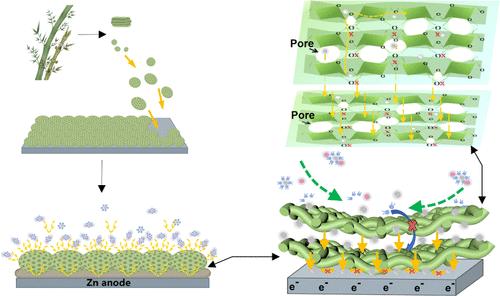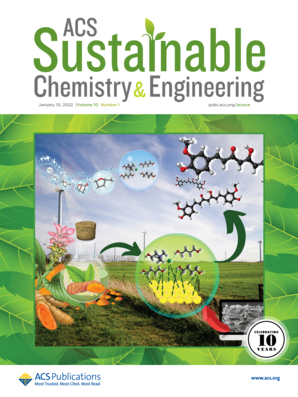水溶锌电池用竹子启发添加剂抑制锌树枝状突起
IF 7.1
1区 化学
Q1 CHEMISTRY, MULTIDISCIPLINARY
引用次数: 0
摘要
可充电锌离子水电池(RAZIB)具有优异的电化学性能、更高的安全性和经济可行性,正在成为可再生能源存储设备的理想候选材料。然而,不均匀沉积导致的不可控寄生反应和锌枝晶的生长阻碍了 RAZIB 的实际应用。在此,受竹子实质细胞(BPC)生物作用的启发,引入了一种仿生电解质添加剂,以提高 RAZIBs 的性能。丰富、易提取、环保的 BPC 添加剂融合了无机材料的结构特征和有机材料的优点。(1) BPC 通过吸附电解液中的 Zn2+,充当阳极上丰富的 Zn2+ 储库,显著减轻了浓度极化。(2) BPC 的三维(3D)多面体结构提供了大量的活性位点,可均化 Zn2+ 通量并抑制阳极上的二维(2D)扩散。(3) BPC 可抑制氢演化腐蚀,并引导 Zn 向更平滑、更致密的晶面沉积。因此,含有 BPC 的对称电池可稳定循环 3000 小时以上,电压滞后极小,半电池在 5 mA cm-2 的条件下循环 380 次,平均库仑效率高达 99.67%。我们的策略展示了一种亲锌生物质材料,可在阳极界面构建均匀富锌和快速传输的界面层,为生物质材料在储能领域的可持续利用铺平了道路。本文章由计算机程序翻译,如有差异,请以英文原文为准。

Suppression of Zinc Dendrites by Bamboo-Inspired Additive for Aqueous Zinc Battery
Rechargeable aqueous zinc-ion batteries (RAZIB) are emerging as promising candidates for renewable energy storage devices, offering superior electrochemical performance, enhanced safety, and economic viability. However, the uncontrolled parasitic reactions and the growth of zinc dendrites resulting from nonuniform deposition impede the practical application of RAZIBs. Herein, inspired by the biological role of bamboo parenchymal cells (BPC), a biomimetic electrolyte additive was introduced to enhance the performance of RAZIBs. Abundant, readily extractable, and environmentally friendly BPC additives integrate the structural characteristics of inorganic materials and the advantages of organic materials. (1) BPC acts as the rich Zn2+ reservoir on the anode by adsorbing Zn2+ from the electrolyte, significantly mitigating concentration polarization. (2) The three-dimensional (3D) polyhedral structure of BPC provides numerous active sites to homogenize Zn2+ flux and inhibit two-dimensional (2D) diffusion on the anode. (3) BPC can suppress hydrogen evolution corrosion and guide Zn deposition toward smoother and denser crystal planes. Consequently, the symmetrical cells containing BPC can stably cycle over 3000 h with minimal voltage hysteresis, and the half-cells exhibit a high average Coulombic efficiency (99.67%) over 380 cycles at 5 mA cm–2. Our strategy demonstrates a zincophilic biomass material for constructing a uniformly zinc-rich and fast-transporting interface layer at the anode interface, paving the way for the sustainable utilization of biomass materials applied in the field of energy storage.
求助全文
通过发布文献求助,成功后即可免费获取论文全文。
去求助
来源期刊

ACS Sustainable Chemistry & Engineering
CHEMISTRY, MULTIDISCIPLINARY-ENGINEERING, CHEMICAL
CiteScore
13.80
自引率
4.80%
发文量
1470
审稿时长
1.7 months
期刊介绍:
ACS Sustainable Chemistry & Engineering is a prestigious weekly peer-reviewed scientific journal published by the American Chemical Society. Dedicated to advancing the principles of green chemistry and green engineering, it covers a wide array of research topics including green chemistry, green engineering, biomass, alternative energy, and life cycle assessment.
The journal welcomes submissions in various formats, including Letters, Articles, Features, and Perspectives (Reviews), that address the challenges of sustainability in the chemical enterprise and contribute to the advancement of sustainable practices. Join us in shaping the future of sustainable chemistry and engineering.
 求助内容:
求助内容: 应助结果提醒方式:
应助结果提醒方式:


